
MWT - A nest full of ospreys!
Ospreys - Population Recovery
Ospreys Return to Breed in Scotland
In 1954, after an absence of nearly 50 years, an osprey pair was reported to have nested at Loch Garten in the Scottish Highlands. They are believed to have successfully raised two chicks that year. They returned to their eyrie in 1955, but persecution by egg thieves proved to be a big problem still. A small group of RSPB staff and volunteers attempted to protect the nest, but despite their valiant efforts it was not until 1959 that young ospreys were raised in the area once more.
The Scottish osprey population steadily grew following the intense persecution in the 1950s and 60s and by 1992, for the first time in over two centuries, more than 100 young ospreys were reared in Britain, albeit confined to Scotland.
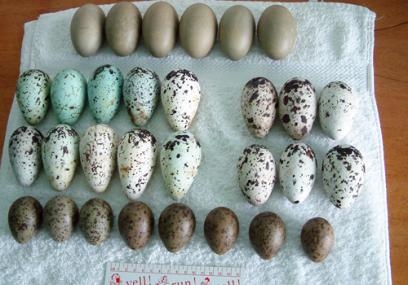
llegal egg collection
Ospreys breed in loose colonies, in Scotland at this time the majority of nests were in the nests Strathspey region. This concentration of nests in one area is due to a behaviour called natal philopatry in male ospreys. This means that male ospreys, once they are old enough to breed - typically at around 3 years old, return to areas close to their original natal sites to breed themselves. In the Scottish colony this behaviour was so strong that 80% of males settled within six miles of their natal site and none dispersed further than 30 miles. So. although osprey numbers were growing their distribution was not.
Translocation Projects
During the 1980's and 90's migrating ospreys were regularly seen stopping off at Rutland Water, in the East Midlands. In an aim to encourage the spread of ospreys throughout the British Isles, the Leicestershire and Rutland Wildlife Trust, in collaboration with Anglian Water, began a translocation project at Rutland Water Nature Reserve in 1996. During each year between 1996 and 2001 up to twelve Scottish osprey chicks were taken from nests containing three young (only one chick was taken from each clutch). These youngsters were then released from pens to fledge at Rutland.
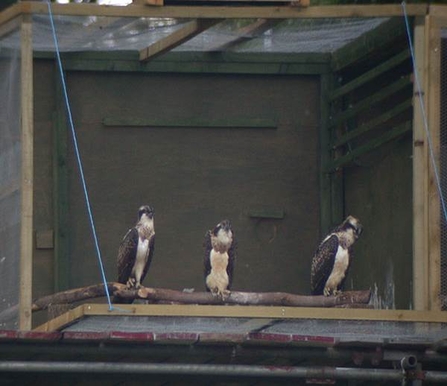
Osprey chicks ready for release at Rutland Water ©Rutland Opsrey Project
Out of 64 birds released in the original programme, at least thirteen are known to have returned to Britain, ten of these to Rutland. One 'superosprey', White 03(97) returned to breed for an incredible 15 years. Sadly his breeding attempt in 2015 was unsuccessful and he failed to return in 2016.
The translocation project has subsequently proved critical to the establishment of the Welsh breeding population. Some of the first ospreys to breed in Wales were those released during the translocation project. White 03/97 has particular significance for the success of the Dyfi Ospreys as he was the farther of Nora (White 03/08) - the first breeding female here at they Dyfi Osprey Project and grandfather to both Glesni (Blue 12/10) - our second breeding female and Telyn (Blue 3J/13) - the current breeding female. Click here for to see how the Rutland females are related.

Nora (White 03/08) battles with crows at the Dyfi nest in 2012
Ospreys in Wales
With the osprey population growing steadily in Scotland and the success of the Rutland translocation project is was only a matter of time until ospreys returned to Wales. Throughout the 80's and 90's there are many references to migrating ospreys stopping off in Wales. Records also show that a breeding attempt was recorded in the 1990’s on the Teifi estuary.
In mid Wales during 1998 and 1999 a female osprey ringed at Lake Muritz, Germany in 1996 over-summered. Ospreys were clearly in the area but not breeding. In an attempt to address this issue a feasibility study was conducted into the possibility of carrying out a Rutland style translocation in Wales during 2003 and 2004, However, the relevant organisations were not supportive of the proposal and the permissions were not granted.
In 2003 there were strong rumours of a pair of ospreys being seen in the Glaslyn Valley, near Porthmadog in Snowdonia. It was too late in the season for a breeding attempt but local birdwatchers decided to keep a close watch on the area the following year.
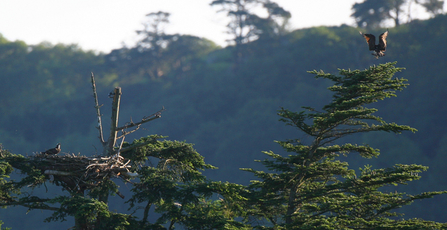
Male and female osprey on their nest at Glaslyn, Snowdonia
In May 2004 a pair of ospreys were found nesting near Croesor in the Glaslyn Valley. This was the first time that the species had been officially recorded as breeding in Wales. The RSPB, with the assistance of several local community groups, set up a protection site and a public viewing area at Pont Croesor. The male bird had an orange (ochre) coloured ring with the number 11 on, and Ochre 11 was soon identified as being one of the Rutland Water translocated chicks from 1998.
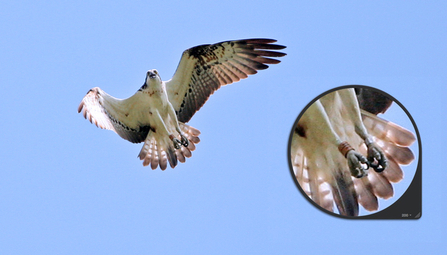
Male osprey Ochre 11(98) in 2005 near Glaslyn, North Wales
Tragically, in early July an unseasonal storm blew most of the nest from the silver fir and both of the two young chicks contained in the nest were killed. Although it was too late in the season to breed again, the pair remained in their territory until they migrated to West Africa at the end of August. The pair returned the following year and the nest has been in productive every year since.
Remarkably, around the same time in 2004 a second pair of ospreys was discovered to be breeding on a nest in a dead Douglas Fir near Welshpool in Mid-Wales. A fisherman spotted an osprey catch a fish and carry it to a distant tree, in which a nest was visible. He reported it to the Montgomeryshire Wildlife Trust and with the help of the landowner and a team of volunteers, the Trust was able to set up a 24 hour protection guard around the nest. The male had a white ring on his right leg numbered 07, which identified him as being one of the 1997 translocated Rutland birds. The female also had a colour ring (Red 6J) on her left leg, she was a 2001 bird hatched in Perthshire. The pair successfully raised one chick, the first recorded Welsh born osprey. Unfortunately, although the male osprey was seen in the area the following year, his mate did not return.
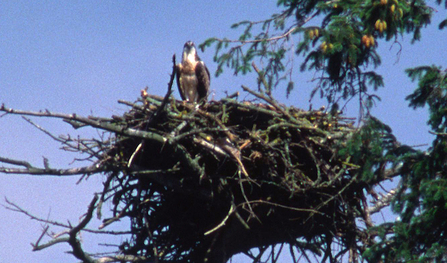
Success! The first ever recorded osprey chick in Wales, June 2004, near Welshpool
In 2007 an osprey nest was put up on Montgomeryshire Wildlife Trust's most westerly nature reserve. This nest would become home to Monty and the Dyfi Osprey Project. You can find out more about how the project began here. Is it possible that Monty is the chick from the 2005 nest near Welshpool? - We may never know but hope that our ongoing work looking at the genetic relatedness of Welsh Ospreys may hold some clues.
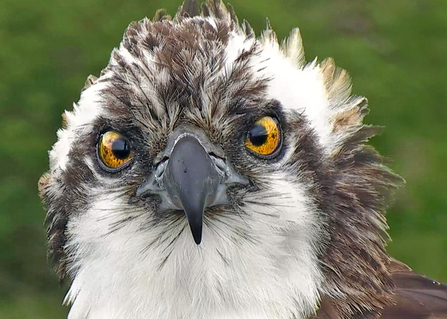
Monty at the Dyfi Osprey Project
The Next Generation
The first few years of life are tough for ospreys. Typically only one -in-three young ospreys will survive to make their first return to the UK either as a non-breeding bird at two years old or as an adult at three years old. Given this harsh statistic it was a source of great hope when on the 26th May 2008 an unidentified osprey briefly landed on the Glaslyn nest, was it possible a Wesh born osprey had returned to Wales?
On 16th July the Dumfries and Galloway Osprey Team reported that they had spotted an osprey at Loch Ken with a black colour ring 80. At the time they believed it was a European ringed osprey, possibly Latvian. The mystery was finally solved on the 28th July when they were able to confirm that Black 80 was in fact a male from the 2006 Glaslyn nest - the first Welsh born osprey known to have returned to Britain to breed. Was it Black 80 that alighted the Glaslyn nest three weeks earlier only to be spurned off by his parents? The following day he was discovered bringing sticks back to a nest, he was clearly building his own nest at the age of two, he had also attracted a female. The pair did not produce any young in 2008 but Black 80 has been breeding at Threave every year since 2009. Between 2009 and 2011 he produced seven chicks with an unringed female and between 2012 and 2017 has produced 14 chicks with female Blue KC/09.
Since Black 80's return in 2008 many other Welsh born ospreys have returned to breed, mainly in the UK but also in Denmark!